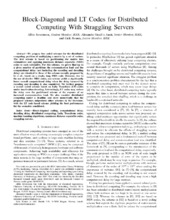| dc.contributor.author | Severinson, Albin | |
| dc.contributor.author | Graell i Amat, Alexandre | |
| dc.contributor.author | Rosnes, Eirik | |
| dc.date.accessioned | 2020-05-18T12:38:06Z | |
| dc.date.available | 2020-05-18T12:38:06Z | |
| dc.date.issued | 2019-03 | |
| dc.Published | Severinson AS, Graell i Amat A, Rosnes E. Block-Diagonal and LT Codes for Distributed Computing with Straggling Servers. IEEE Transactions on Communications. 2019;67(3):1739-1753 | eng |
| dc.identifier.issn | 0090-6778 | en_US |
| dc.identifier.issn | 1558-0857 | en_US |
| dc.identifier.uri | https://hdl.handle.net/1956/22296 | |
| dc.description.abstract | We propose two coded schemes for the distributed computing problem of multiplying a matrix by a set of vectors. The first scheme is based on partitioning the matrix into submatrices and applying maximum distance separable (MDS) codes to each submatrix. For this scheme, we prove that up to a given number of partitions the communication load and the computational delay (not including the encoding and decoding delay) are identical to those of the scheme recently proposed by Li et al., based on a single, long MDS code. However, due to the use of shorter MDS codes, our scheme yields a significantly lower overall computational delay when the delay incurred by encoding and decoding is also considered. We further propose a second coded scheme based on Luby transform (LT) codes under inactivation decoding. Interestingly, LT codes may reduce the delay over the partitioned scheme at the expense of an increased communication load. We also consider distributed computing under a deadline and show numerically that the proposed schemes outperform other schemes in the literature, with the LT code-based scheme yielding the best performance for the scenarios considered. | en_US |
| dc.language.iso | eng | eng |
| dc.publisher | IEEE | en_US |
| dc.title | Block-Diagonal and LT Codes for Distributed Computing with Straggling Servers | en_US |
| dc.type | Peer reviewed | |
| dc.type | Journal article | |
| dc.date.updated | 2020-01-20T15:56:12Z | |
| dc.description.version | acceptedVersion | en_US |
| dc.rights.holder | Copyright 2018 IEEE. Personal use of this material is permitted. Permission from IEEE must be obtained for all other uses, in any current or future media, including reprinting/republishing this material for advertising or promotional purposes, creating new collective works, for resale or redistribution to servers or lists, or reuse of any copyrighted component of this work in other works. | en_US |
| dc.identifier.doi | https://doi.org/10.1109/tcomm.2018.2877391 | |
| dc.identifier.cristin | 1711980 | |
| dc.source.journal | IEEE Transactions on Communications | |
| dc.relation.project | Norges forskningsråd: 240985 | |
| dc.relation.project | Vetenskapsrådet: 2016-04253 | |
| dc.identifier.citation | IEEE Transactions on Communications. 2019, 67 (3), 1739-1753. | |
